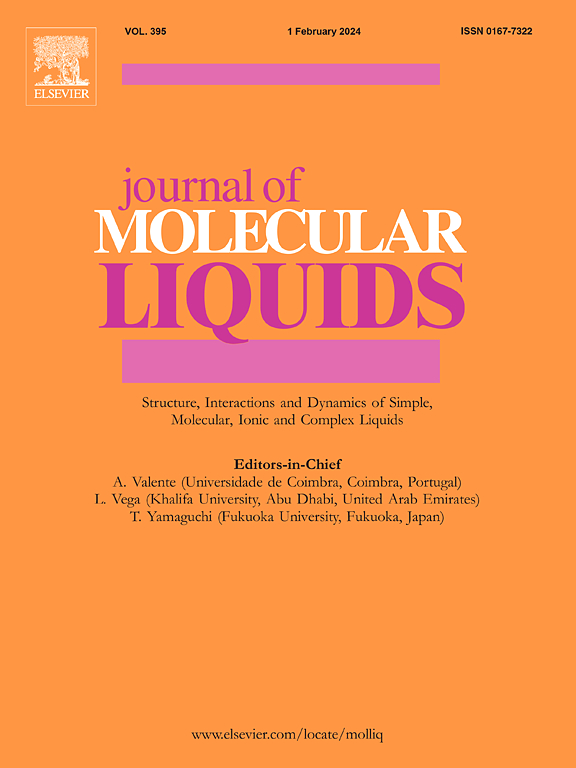含蜡原油乳状液在集输管道粘壁过程中的分子运动行为研究
IF 5.3
2区 化学
Q2 CHEMISTRY, PHYSICAL
引用次数: 0
摘要
中国拥有丰富的含蜡原油储量。然而,随着采油管道中操作温度的降低,原油中的蜡分子逐渐沉淀。这种现象引起原油粘度的增加。这些变化加剧了粘壁倾向,导致管道加速堵塞。本文通过分子动力学模拟和实验方法,研究了含蜡原油在不同含水条件下的粘壁行为。模拟结果表明,随着含水量的增加,管壁上水分子的密度分布值从0.17 g/cm3上升到5.44 g/cm3,表明管壁上水的分布行为增强。体系粘壁性能减弱。在较低的油温和较高的壁面粗糙度条件下,含蜡原油的粘壁行为也更加明显。此外,随着壁面粗糙度的增加,微观壁面凹槽内C12H26分子的峰值浓度从6.49上升到9.47,而C18H38分子的峰值浓度从4.63下降到0.01。对比分析表明,随着模拟时间的延长,光分量向不规则表面区域渗透的趋势越来越强。值得注意的是,随着表面粗糙度的增加,胶凝原油的结构强化趋势越来越明显。不同壁材和含水率下的粘壁实验分析表明,随着含水率从70%增加到95%,胶凝原油的聚集面积从468.0 mm2减少到177.0 mm2,表明粘壁行为逐渐减弱。玻璃管和不锈钢管的胶凝原油聚集面积分别为321.5 mm2和358.2 mm2。与分子动力学模拟结果一致,观察到粗糙的管壁表面表现出更明显的粘附行为。实验和模拟结果不仅有助于从微观分子运动角度理解胶凝原油的粘壁特性,也为工程应用中去除粘壁、减少胶凝原油堆积提供了思路。本文章由计算机程序翻译,如有差异,请以英文原文为准。
Study on molecular motion behavior during the wall sticking process of waxy crude oil emulsion in gathering and transportation pipeline
China possesses abundant reserves of waxy crude oil. However, as the operational temperature decreases in gathering pipelines, wax molecules within the crude oil progressively precipitate. This phenomenon triggers an increase in the viscosity of the crude oil. These changes exacerbate the wall-sticking propensity, leading to accelerated pipeline blockage.In this study, the wall-sticking behavior of waxy crude oil under varying water cut conditions is investigated through molecular dynamics simulations and experimental approaches. The simulation results revealed that as the water content increased, the density distribution value of water molecules on the pipe wall rose from 0.17 g/cm3 to 5.44 g/cm3, indicating enhanced distribution behavior of water on the wall. The wall sticking behavior of system is weakened. Under conditions of lower oil temperatures and increased wall surface roughness, the wall sticking behavior of waxy crude oil also became more pronounced. Furthermore, as wall surface roughness increases, the peak concentration of C12H26 molecules within microscopic wall grooves rises from 6.49 to 9.47, whereas the peak concentration of C18H38 molecules decreases from 4.63 to 0.01. This comparative analysis reveals that with prolonged simulation time, light components exhibit a stronger tendency to infiltrate irregular surface regions. Notably, as the surface roughness escalates, the structural reinforcement trend of the gelled crude oil becomes progressively more pronounced. Experimental analysis of wall sticking under different wall materials and water content levels demonstrated that as the water content increased from 70 % to 95 %, the accumulation area of gelled crude oil decreased from 468.0 mm2 to 177.0 mm2, indicating a gradual weakening of wall sticking behavior. The accumulation area of gelled crude oil for glass and stainless steel tubes were measured at 321.5 mm2 and 358.2 mm2, respectively. Consistent with molecular dynamics simulation results, it was observed that rougher tube wall surfaces exhibited more pronounced sticking behavior. The experimental and simulation results not only contribute to understanding the wall-sticking characteristics of gelled crude oil from the perspective of molecular motion at micro scales but also provides insights for the removal of wall sticking and reduction of accumulation of gelled crude oil in engineering applications.
求助全文
通过发布文献求助,成功后即可免费获取论文全文。
去求助
来源期刊

Journal of Molecular Liquids
化学-物理:原子、分子和化学物理
CiteScore
10.30
自引率
16.70%
发文量
2597
审稿时长
78 days
期刊介绍:
The journal includes papers in the following areas:
– Simple organic liquids and mixtures
– Ionic liquids
– Surfactant solutions (including micelles and vesicles) and liquid interfaces
– Colloidal solutions and nanoparticles
– Thermotropic and lyotropic liquid crystals
– Ferrofluids
– Water, aqueous solutions and other hydrogen-bonded liquids
– Lubricants, polymer solutions and melts
– Molten metals and salts
– Phase transitions and critical phenomena in liquids and confined fluids
– Self assembly in complex liquids.– Biomolecules in solution
The emphasis is on the molecular (or microscopic) understanding of particular liquids or liquid systems, especially concerning structure, dynamics and intermolecular forces. The experimental techniques used may include:
– Conventional spectroscopy (mid-IR and far-IR, Raman, NMR, etc.)
– Non-linear optics and time resolved spectroscopy (psec, fsec, asec, ISRS, etc.)
– Light scattering (Rayleigh, Brillouin, PCS, etc.)
– Dielectric relaxation
– X-ray and neutron scattering and diffraction.
Experimental studies, computer simulations (MD or MC) and analytical theory will be considered for publication; papers just reporting experimental results that do not contribute to the understanding of the fundamentals of molecular and ionic liquids will not be accepted. Only papers of a non-routine nature and advancing the field will be considered for publication.
 求助内容:
求助内容: 应助结果提醒方式:
应助结果提醒方式:


